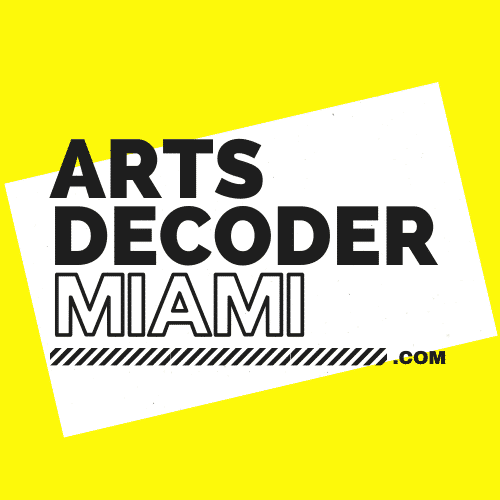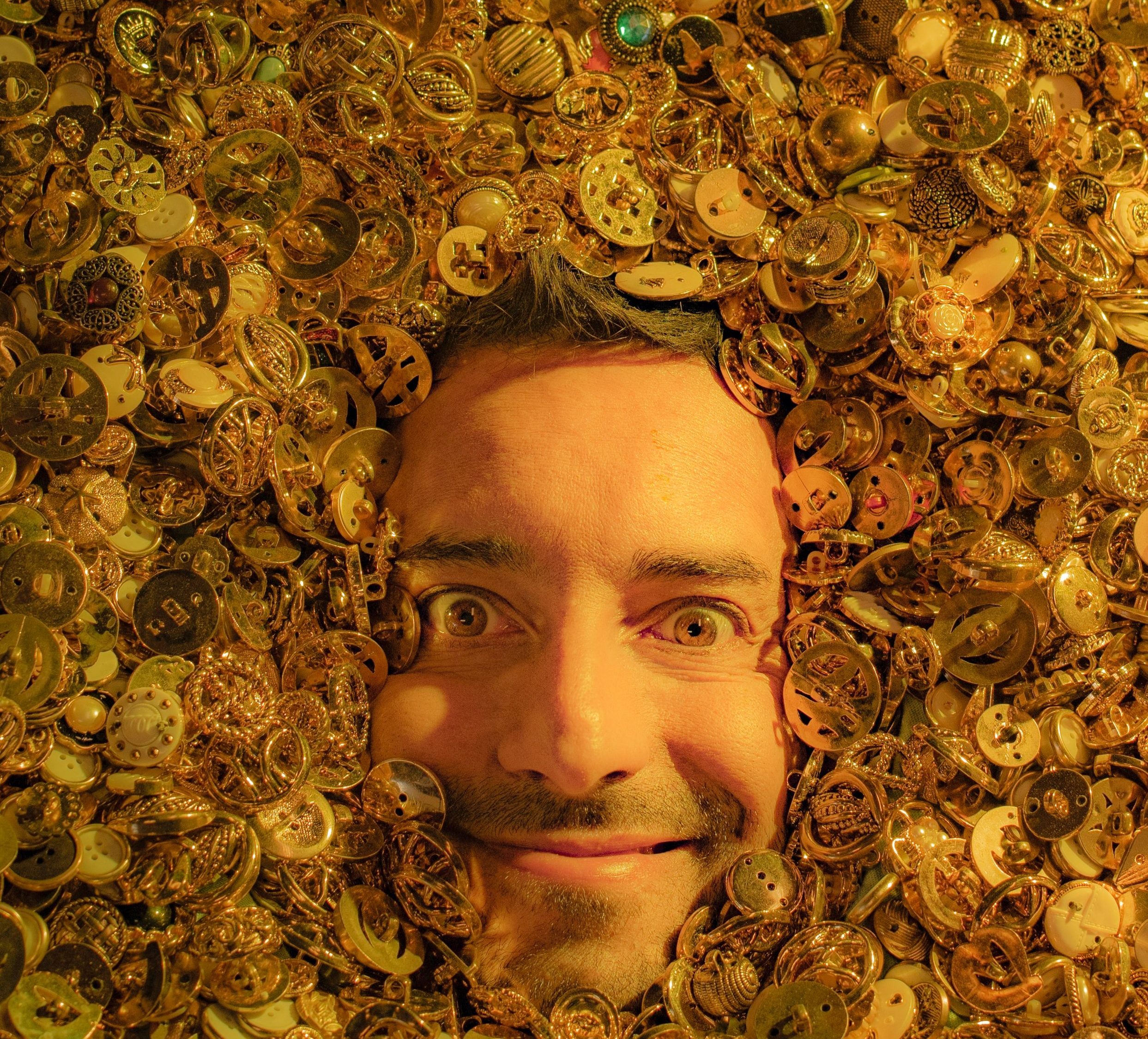
Augusto Esquivel (The Button Man Artist)
We had the privilege of getting to know Miami’s very own “Button Man”, Augusto Esquivel, whose artistry is a button-filled one and loved by so many. Check out our conversation below!
Hello Augusto! How did you begin your journey into the world of art?
More than 10 years ago, almost 20 years ago, I started working for an artist here in Miami as an assistant. Working with this artist, I discovered that not only did I have the skills to create things with my hands but, I also had a lot of ideas that I wanted to develop. Another thing this artist showed me was that this artist was able to make a living from his creations. So, that for me was a mind opener. Being able to find that there were structures where I could make a living out of my creations was really an eye-opener and I am thankful that I learned a lot from this artist. I also learned that it was not easy to make a living as an artist but, that it was possible. The possibility for me was the key point to say let’s try it, let’s do it.
Wonderful! In Miami, we know you as the button artist.
People usually don’t remember my face or my name but, they’ll say, “Oh yeah, the button artist.” They would show me pictures from many years ago and say, “I took a picture of your sculpture.” I used to be the Button Guy, now, I’m the Button Man. Maybe, it’s because I am getting older that I am not the Button Guy anymore.
We saw on your Instagram page in your bio section where it states, “Even a button wants to be something.” You’re a sculpturist who creates sculptures out of buttons. Why buttons?
I knew I wanted to create sculptures and bring a lot of objects together to make something bigger than themselves. When I was looking for objects, I came across a bag of buttons, I think it was out of Michaels or another craft store. It reminded me of my grandmother. She used to have a tin can full of buttons. I find that a lot of people’s grandmothers have this tin can.
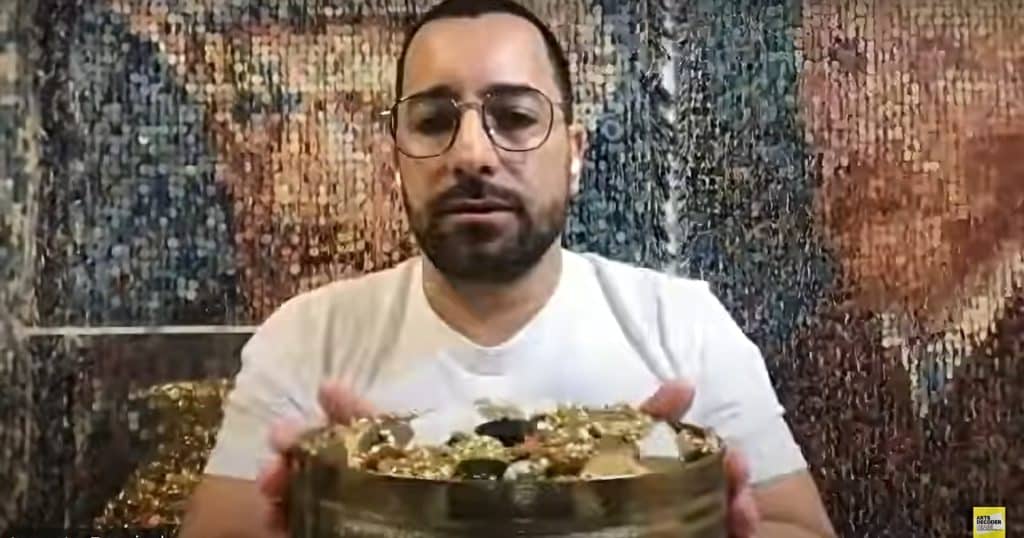
I thought it could be a really fun and interesting material to work with. I was looking for an unconventional object to work with. After I started working with buttons, I realized that there are so many different types of buttons. I started to get into the history of the button. I became a part of the National Button Society. Imagine something like that exists! It’s for people who collect buttons and go to button fairs to exchange buttons, buy buttons and compete with their buttons. I’m learning a lot with buttons. I find them really beautiful.
I discovered that they have that universality. It’s a very common object and I think that it’s beautiful that I can give this object a second life. That’s where the saying, “Even a button wants to be something” comes from. I didn’t come up with that phrase. I think I heard it in a movie, where they were talking about even a brick wants to be something and it was a talk that was given to architects. It totally fit what I had in mind and with the material I was currently working with. I wanted the button to become something else to have a different functionality – different from the one that it was created for. I like that metaphor that we shouldn’t underestimate the objects we have around, that everything can be used to elevate it to be a piece of art – fine art or just something fun and something functional. But, I think it also ties to having a mindset of recycling and upcycling, using the materials we have around us to see that they have a second life. That we can give them a second life. They don’t have to be discarded. They don’t have to be in landfills. They can still be used to give us functionality.
Wow! That’s amazing! There are different types of buttons from what we read in your biography.
It’s innumerable. The materials, the types, the eras, you name it, bones, shells, plastic, wood, acrylic, glass, precious stones, and coconut shells. There are a lot of coconut shell buttons. You can make buttons out of ivory. I think as humanity when we look around, whatever we have at hand, we transform it into buttons.
When I see the different types of buttons, it shows a little bit of the history of humanity and how we solved things by working with the materials we had around us. That’s exactly what I’m doing! Instead of trashing the buttons and not looking at them, I can reuse this material. I also find that a lot of people when they come to my studio and they see my work, they would confess to me, “I save all the buttons that I come across and I have a drawer full of buttons. I don’t know what to do with them. I don’t want to throw them away.” I find these people who see the intrinsic value of the button. They know they are never going to use them. So, I encourage them that they cannot only do sculptures but they can do a lot of crafts – necklaces, jewelry, and scrapbooking. If I can inspire people to give a second life to the button then, I think I am doing my job.
How do you find your buttons besides at the fairs?
At the fairs, I don’t get any buttons because those are the collector’s buttons. They are very expensive and one-of-a-kind. They are high-end buttons. It wouldn’t be feasible for me to use those buttons. I use plastic or resin buttons. I scout online. I go to different websites that sell craft materials. I go to places like the Salvation Army. In those places, you can find in the back on a forgotten shelf a jar of buttons that a person kept saving. A lot of people donate their buttons by bringing them to my studio. Many times, I’ll accept their buttons and make sure I let them know which sculpture I am using those buttons in.
Some people have an emotional attachment to their buttons. I remember this guy from Cuba. Out of all of the things he brought from Cuba, he brought the buttons of his grandmother. I wanted to honor that journey that the buttons had. I told him this was going to go in this sculpture that had this emotional charge for me. I think we were closing a circle for that material. I find buttons through Amazon and Temu. I remember a long time ago, this was a one-time thing. A shop was going out of business and the owner gave me a lot of buttons that he had in his shop for a very cheap price. I was like a kid in a candy store. He was like you can choose whatever you want. I was like I want this one, this one and this one. I got about 150 pounds of buttons. It was like I hit the jackpot. That was a long time ago. I still have a few of them. I’m always paying attention if someone is giving away buttons. I go to craft stores too. But, mostly I buy online.
You’ve created button art of animals, plants, natural landscapes, a Coke vending machine to Van Gogh, Marilyn Monroe and Albert Einstein self-portrait sculptures just to name a few because you have so many. Which of your creations is your favorite?
I think I connect with all of them. Each piece gave me something. When I first started creating button sculptures, I didn’t know if the sculpture would work, if people were going to get it and if the image was going to come out right or the way I wanted it. I was working with a lot of uncertainty. When I was working on a portrait for example, almost up until the end I didn’t know if that piece was going to work. When it did work, then that piece gave me a lesson that I was learning, that I could apply to the next one. This was not only for the portraits but, the 3D objects and animals that I did. Each one of them taught me something, so it’s very hard for me to choose a favorite one. On my website, you see the ones that work and the sculptures that I am satisfied with. But, there were a lot of them that didn’t work and I had to start all over again and reuse the buttons. It was important to pay attention to the technique because the process is so labor-intensive. If I’m at the last stage of creation and it doesn’t work then, I’ve lost a lot of time and a lot of materials. So, that feeling of putting in place the last button and realizing the sculpture worked. I love the piece for that! It’s like good, it’s a successful sculpture, portrait or object. So, it’s very hard for me to say I like this one over this one. Each one of them taught me something.
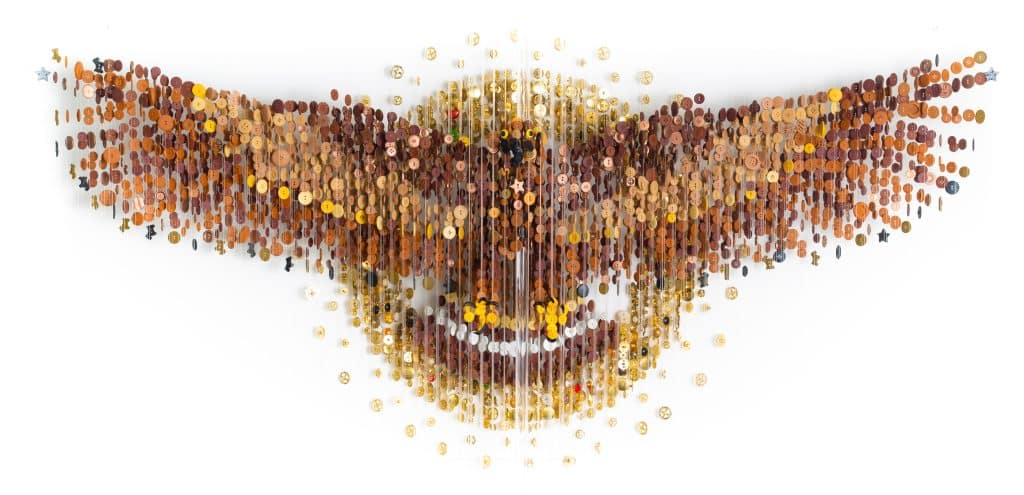
Golden Eagle (2018)

Pine Tree Landscape (2013)
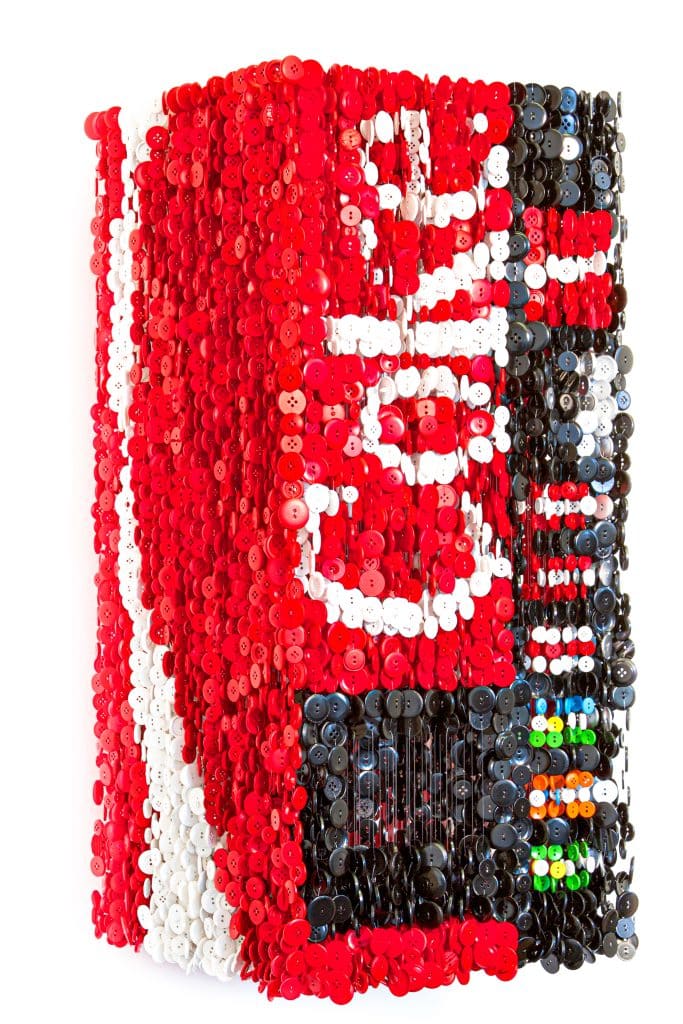
Coke Vending Machine
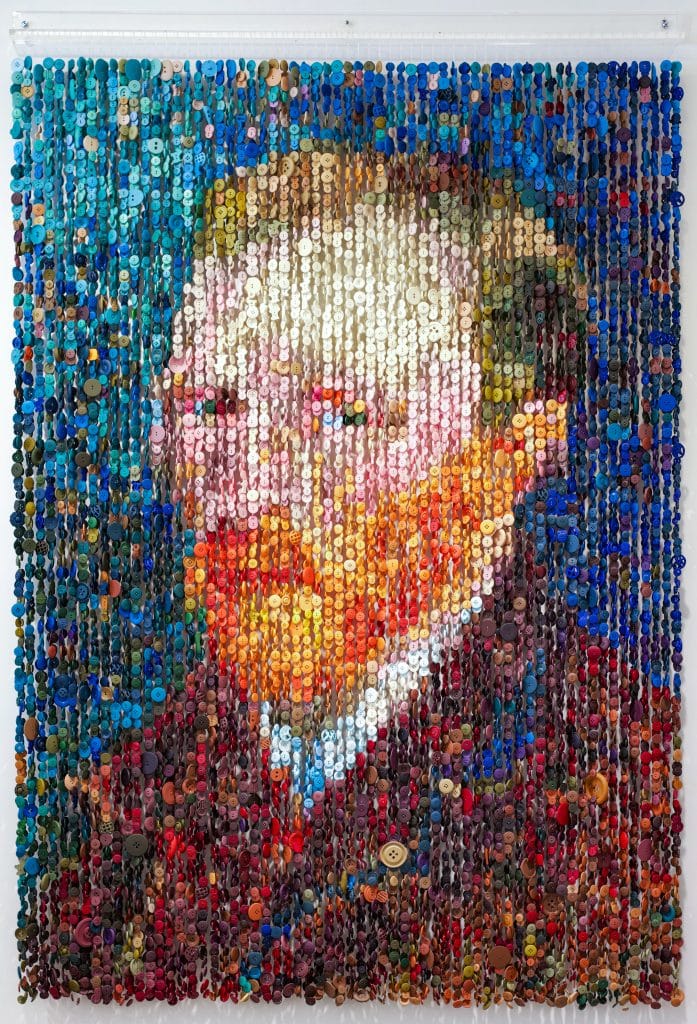
Van Gogh
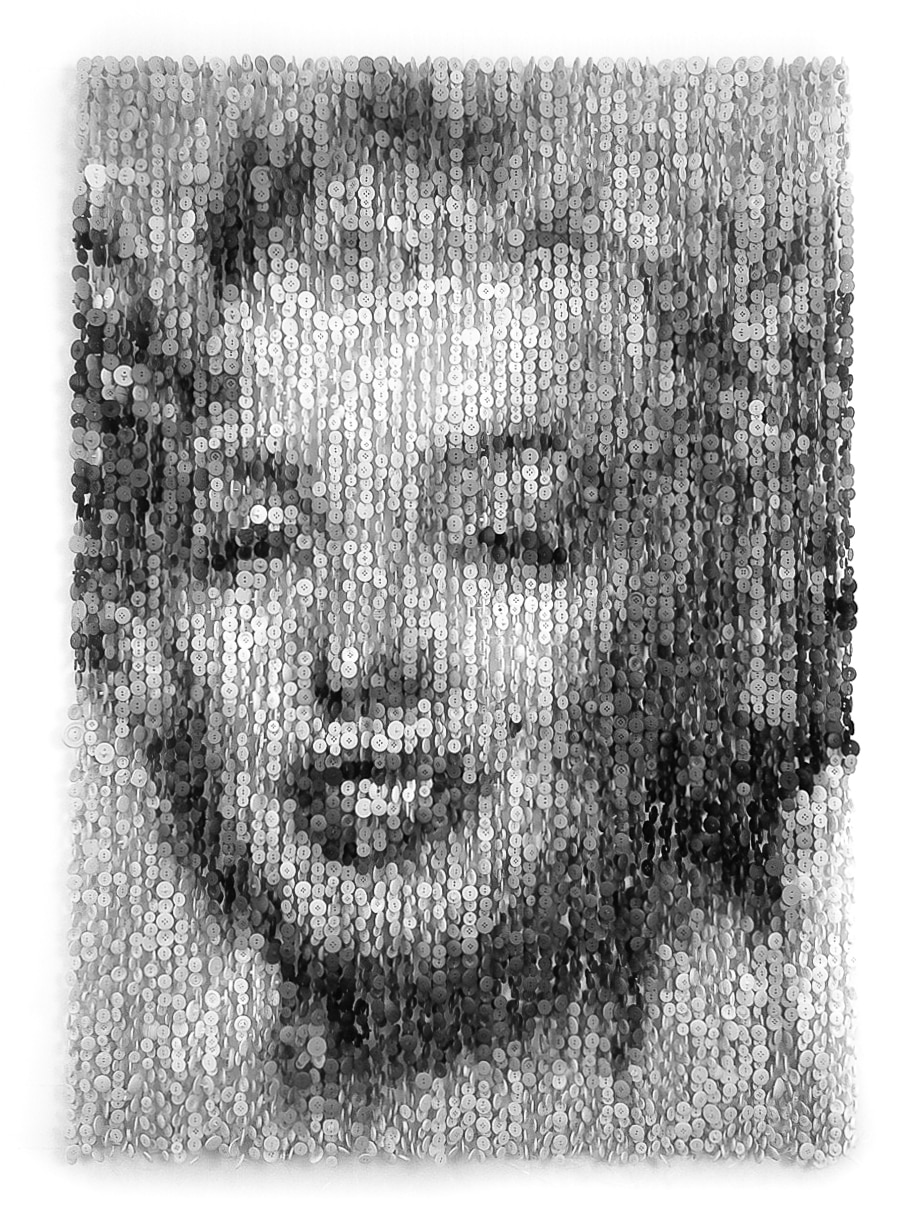
Marilyn Monroe (2012)
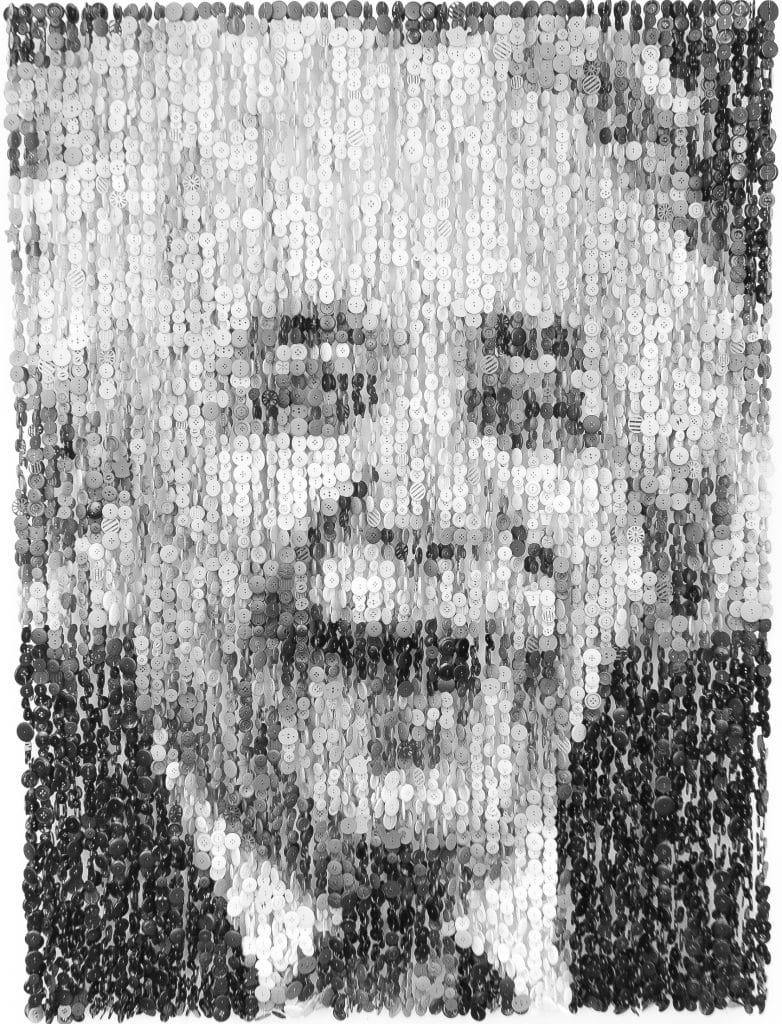
Albert Einstein (2015)
That’s a wonderful answer because in my mind I’m like wow they all connect someway and somehow to each other. As you previously stated, they build upon each other.
Yeah, totally! They teach me. I appreciate that the process gave me all of that experience, not only on the skill side, but, when it comes to being patient. I’m working on patience. I’m working on allowing myself to let things go and not to be in control all the time to realize when things don’t work it’s a teaching moment also. I’m working with frustration. It’s a whole process. A lot of people come, they see my work then, they realize how long it takes and they tell me there is no way I could do that. When I enjoy the process, I realize that I’m lucky that I can do what I do and that I found a process that I enjoy.
I feel a lot of people do not have the job that they want and they’re not as fulfilled and happy with what they do. They have to get that job because it’s what they have to do and that is understandable. I’ve had those jobs before having this. It’s like the cherry on top that not only is a piece successful but, it’s giving me so much and it’s teaching me so many good lessons. I’m not saying that I’m like this enlightened artist, not at all. I’m learning all the time and I make mistakes too. But, I am very lucky to have a job from beginning to end that is good for me, and gives me pleasure and lessons to learn.
Yes, very lucky! You’re right not everyone is working their dream job or their passion job, but, you’re able to do so. It’s like every day in your life is a gift.
Totally!
What is the largest button art creation that you’ve made and how long did it take you to create it?
There are a few. I did an upright piano and that took me like three months to create. I remember I had to set up and paint more than 60 pounds of buttons. There’s another one I did, a phone booth, you know those red English phone booths?
Yes!
It wasn’t only a booth but, inside it had a landscape with a waterfall. It was a life-size phone booth. The other one was big and complicated. It had so many moving parts, literally. Do you know that claw machine that picks up toys like teddy bears and stuff?
Yes!
So, I did one of those machines. It was not my idea but, a person saw what I did and asked me if I could make one. I was challenged as he gave me a list of toys he wanted to have inside of the machine. I was thinking, I have no idea if I will be able to pull this through. I pushed my technique to the limit and I was able to do it. It took me about four and a half to five months to create the design and set up the buttons from beginning to end.
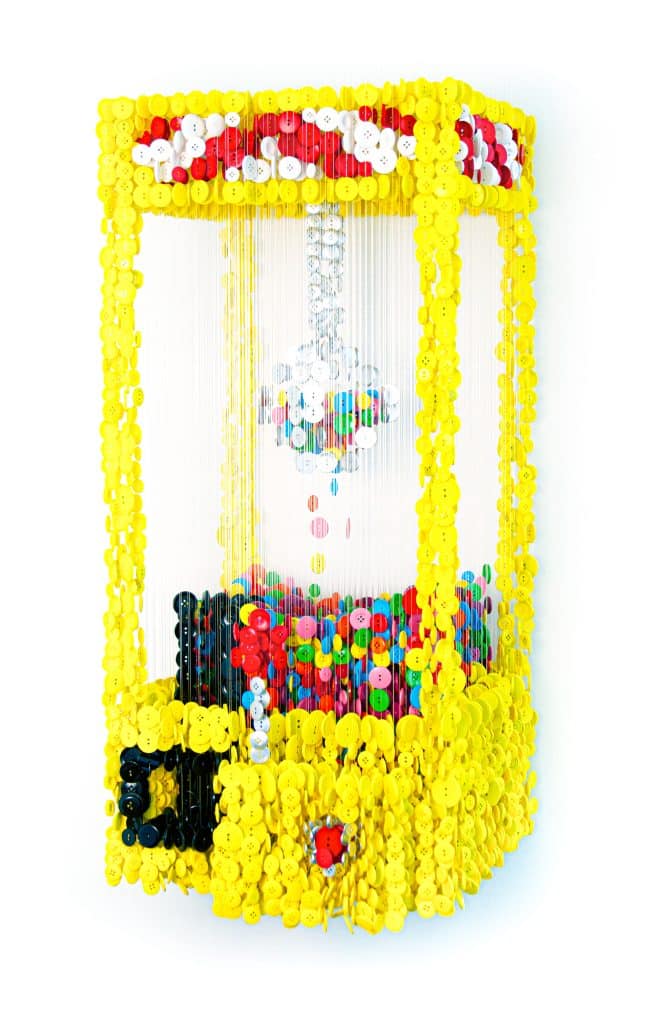
Candy Crane (2013)
You mentioned that you paint each button?
Correct! It depends on the piece that I am creating. Some of the buttons I have to spray paint. I have a lot of golden buttons and I don’t spray paint those. The vast majority of them that I spray paint are placed on a piece of wood and sprayed. The wood comes out with all these patterns.
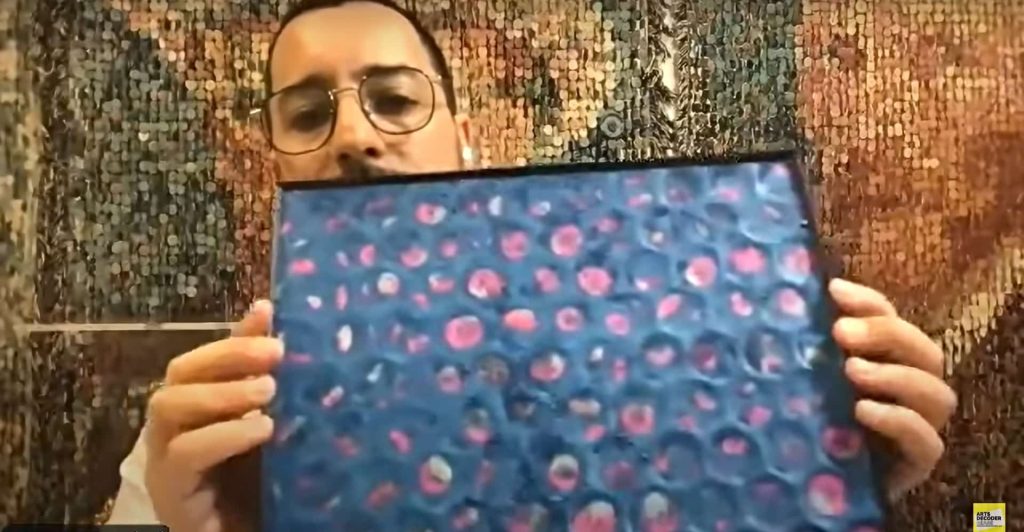
Wow! That’s amazing!
For many years, people would tell me that I should frame them because they like them. I have other artist friends who come here and they would take them and use them as shelves or small coffee tables. Finally, I framed them. The patterns look really cool. It’s like a cool accident.
What is your motivation to get yourself into a creative mindset?
Usually, when I am working on a sculpture that’s when I start to get ideas for the next sculpture. I can understand what the technique allows me to do and when it works I’m like okay I can go the next step. I think I can do the basic shapes then, I can do animals. Now, I can do that face with distinctive characteristics. I’m understanding the technique and the technique gives me a new menu of things I can create and directions I can go in creating. That’s really inspirational for me. I know what the technique is allowing me to do. Sometimes the idea is too big or too ambitious and it doesn’t work. But, creating just makes the whole environment for me more creative. Being around the material, working with the material and seeing the material is what helps me to have that creative mindset.
That’s awesome! You’re known internationally. Where are some places and spaces where you’ve displayed your artwork?
Mostly, I am in private collections. I have a lot of private collectors from South America, a few in Europe, and a lot in the United States. I have one piece in the Spotify building here in Miami. It was one of my first public artworks. I’m lucky enough to be working with a gallery that goes to different art fairs in Columbia, New York, The Hamptons, Miami and Palm Beach.
Congratulations! That is a lot of accomplishments. You’re artwork has been all around. You’ve mentioned the Spotify building was where your first piece was displayed?
Yes, the first public art that I’ve done is displayed at the Spotify building. I think the name of the room is Tropical Room. You can go and check it out. The sculpture can be seen on my website and there is a video of it on my Instagram.
What is your most memorable moment in your artistic journey?
I hope it’s not cliché but, when I had my first idea and I created that sculpture, I took that sculpture to the artist that I was working with because I respected his opinion. I asked him to critique my work and give me his opinion. He looked at the piece for five minutes. I think that was the longest five minutes of my life. Then, he said, “I think there is something here. You should keep working.” When I heard that, it was as if he was telling me I was a great artist. It was like being validated like I have something here. He didn’t say it was good or bad but, he could tell something was there and that I should keep exploring. That’s what I did and that is what I am still doing. Keep exploring! That is something we all should do especially artists. That’s something that I remember ’til this day, that there is something here and I should keep exploring.
As you keep exploring, what are some goals you would like to achieve in the next five years as an artist?
I would like to have more work in public spaces. I appreciate my private collectors because of them I am here and I can make a living. But, I would like for my art to be able to be in places where more people can see it. The more people that I can reach to see my work means I can inspire them to the point where they look at my work and say, “That artist must be crazy and has a lot of patience” or “It’s beautiful! I want to have one but, I have questions”.
How can our audience reach you?
They can go to my website, www.augustoesquivel.com. They can go to my Instagram account which is @augustomuchogusto. They can find me on TikTok and Youtube. But, Instagram is where I am more active. They can reach me there and send me a message if they have a question. I always try to answer all the questions that have to do with my work because I want people to feel curious about not only my work but, the art world in general.
Thank you so much Augusto for your time today and for joining us for this interview!
You’re most welcome! I really appreciate your questions, your patience and your interest in including me in this series. So, thank you!
Contact Augusto Esquivel
Website: www.augustoesquivel.com
Instagram: www.instagram.com/augustomuchogusto
